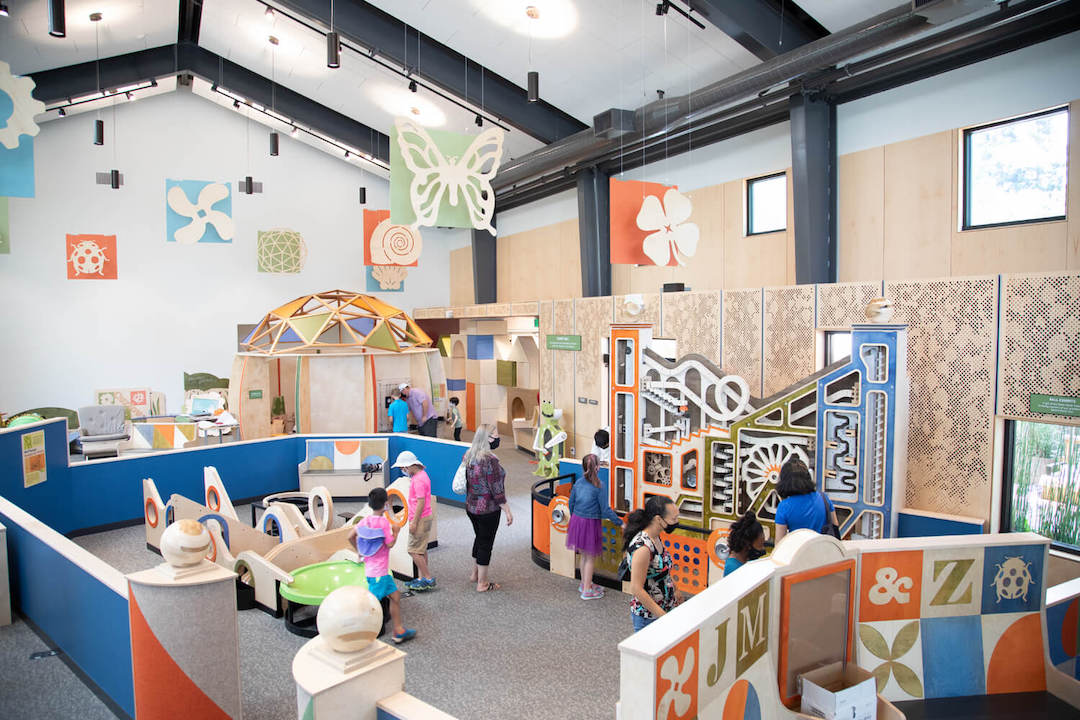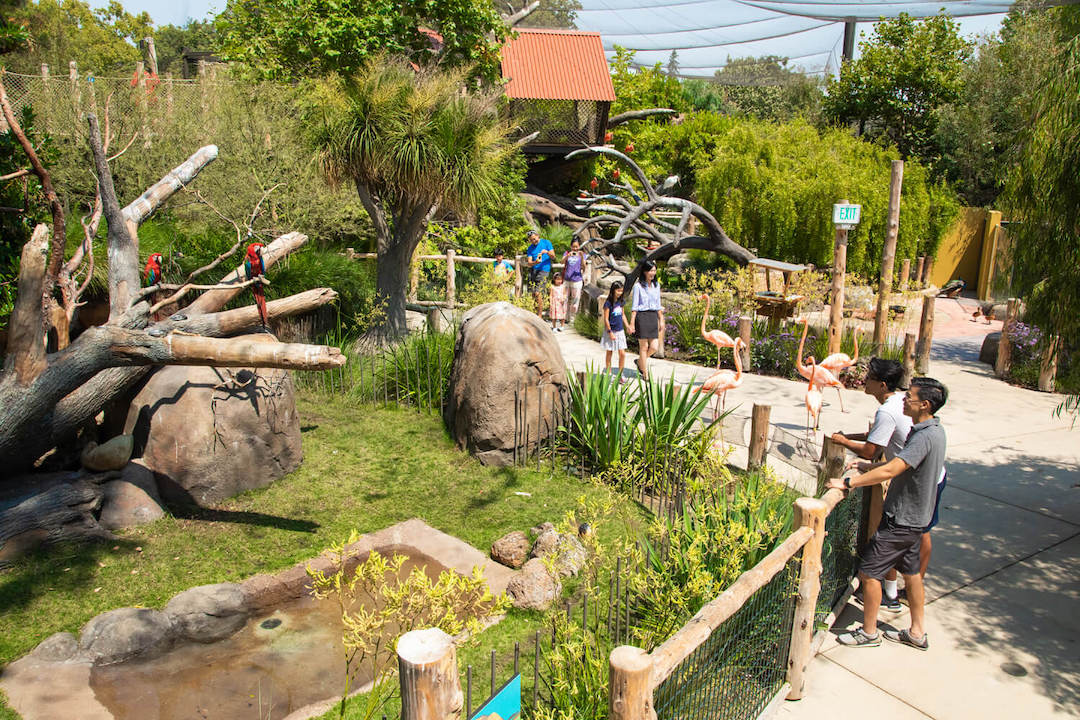The Palo Alto Junior Museum and Zoo (JMZ) has completed, CAW Architects recently announced. Located within the Palo Alto Arts and Recreation District, the project replaces the original JMZ facility. The project area spans three acres and includes a 15,200-sf building and the 18,800-sf zoo (including back-of-house spaces).
CAW Architects worked with Studio Hansen Roberts to design a new children’s museum and zoo that rethinks how to capture a child’s wonder and curiosity for the natural world and create interactive learning experiences throughout. Organized around an exhibit hall, education center, and outdoor zoo, the new design creates a strong visible presence through a large entrance porch and a variety of free outdoor exhibit spaces. The exhibit spaces extend into the adjacent surroundings and include the stump maze, the rainbow tunnel, and porch swings.

The building forms fit a residential and agrarian vernacular with simple clean forms and shed roofs, which echo the surrounding neighborhood. The building shapes fit in and around existing mature oaks and feature trees, where the buildings create theme-based outdoor courtyard spaces, such as the Jurassic courtyard, for specific educational opportunities.
The exhibit hall contains a variety of interactive and kinesthetic exhibits in which children can interact. Several large windows and skylights directly link the zoo with the exhibit hall, with some exhibits extending from the zoo directly into the museum.

The entire zoo is designed as a large aviary, allowing a wide range of birds to directly interact with the children. The exhibits within the zoo are layered vertically to give kids an opportunity to view the natural environment from different vantage points. The design allows children to experience the natural environment of spaces below such as tree roots and water ponds, while also creating spaces above, for children to explore up in the central tree to then look down on the various zoo experiences. A tree house runs through the center of the zoo and connects all the spaces with rope bridges, ladders, net tubes, and platforms to create a play-based experience for children.
CAW Architects' work on the project included the site masterplan, including the museum, zoo, and education center to integrate it into the overall city complex; architectural design and interior design of the museum, education wing, and administrative support spaces; and site design including exhibit spaces around the museum exterior, zoo exhibit spaces, and zoo support spaces.
In addition to CAW Architects and Studio Hansen Roberts, the project team also included:
- Landscape Design: Vallier Design
- General Contractor: Vance Brown Builders
- Structural Engineer: Hohbach Lewin
- Specialized Structural Engineer: Coffman Engineers INC.
- Giotechnical Engineer: Silicon Valley Soil Engineering
- Civil Engineer: C2G
- Mechanical/Plumbing: ACCO Engineered Systems
- Electrical Engineer: H.A. Bowen Electric
- Project Arborist: HortScience, Inc.
Related Stories
| Feb 18, 2014
Robert A.M. Stern sent back to drawing board for Revolutionary War museum in Philadelphia
The Philadelphia Art Commission has suggested some significant changes to the design by Robert A.M. Stern Architects, namely the elimination of a cupola and the addition of eye-level windows on the ground floor.
| Feb 14, 2014
Giant interactive pinwheel adds fun to museum exterior
The proposed design for the Santa Cruz Museum of Art and History features a 10-foot pinwheel that can be activated by passersby.
| Feb 14, 2014
Crowdsourced Placemaking: How people will help shape architecture
The rise of mobile devices and social media, coupled with the use of advanced survey tools and interactive mapping apps, has created a powerful conduit through which Building Teams can capture real-time data on the public. For the first time, the masses can have a real say in how the built environment around them is formed—that is, if Building Teams are willing to listen.
| Feb 13, 2014
Extreme Conversion: Nazi bunker transformed into green power plant, war memorial
The bunker, which sat empty for over 60 years after WWII, now uses sustainable technology and will provide power to about 4,000 homes.
| Jan 30, 2014
How reverse engineering nature can spur design innovation
It’s not enough to copy nature. Today’s designers need a deeper understanding of environmental nuance, from the biome in.
| Jan 28, 2014
16 awe-inspiring interior designs from around the world [slideshow]
The International Interior Design Association released the winners of its 4th Annual Global Excellence Awards. Here's a recap of the winning projects.
| Jan 28, 2014
Big Ten Conference opens swanky HQ and museum [slideshow]
The new mixed-use headquarters includes a museum, broadcast studios, conference facilities, office spaces, and, oh yeah, a Brazilian steakhouse.
| Jan 13, 2014
Custom exterior fabricator A. Zahner unveils free façade design software for architects
The web-based tool uses the company's factory floor like "a massive rapid prototype machine,” allowing designers to manipulate designs on the fly based on cost and other factors, according to CEO/President Bill Zahner.
| Jan 11, 2014
Getting to net-zero energy with brick masonry construction [AIA course]
When targeting net-zero energy performance, AEC professionals are advised to tackle energy demand first. This AIA course covers brick masonry's role in reducing energy consumption in buildings.
| Dec 30, 2013
Calatrava facing legal action from his home town over crumbling cultural complex
Officials with the city of Valencia, Spain, are blaming Santiago Calatrava for the rapid deterioration of buildings within its City of Arts and Sciences complex.
















